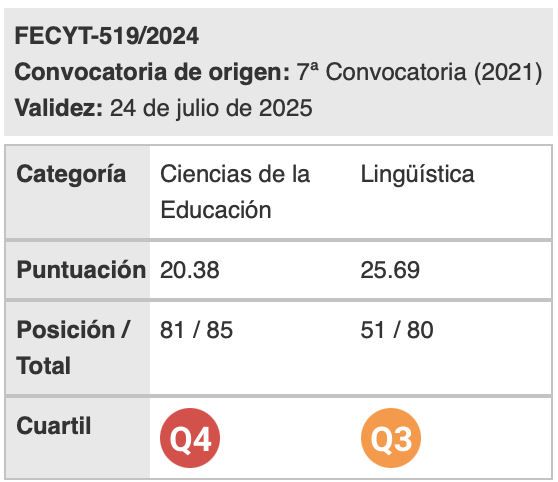Anglicisms in Spain: Gender Assignment and Plural Formation in Touristic Texts
Palabras clave:
anglicisms, touristic texts, inflectional morphology, borrowing integrationResumen
It is traditionally assumed that the influence of English upon Spanish is par- ticularly pervasive in the area of languages for specific purposes. In the case of the language of tourism it is more complicated than in other areas, as it covers several subfields, for example economics, history of art, marketing, sports, law, etc. We have carried out previous research on the presence of loanwords in tourism and computer language showing the increasing influence of English. The present study analyses the frequency and usage of anglicisms in the language of tourism in five different publications aimed at the general public, as well as web pages. Most of the articles and pages are related to adventure sports and rural tourism.
In our analysis we examine their adaptation to the system in terms of gender assignment and plural formation to determine whether English loanwords in Spanish are governed by usual criteria regarding gender assignment. We shall see whether the English pattern prevails over the Spanish one or if there is a mix- ture of both methods. Finally, we will focus on the type of coinage that is derived once the item has been introduced in Spanish; some of the terms remain as sporadic code-switches, but others can be regarded as real borrowings that develop into derivatives or undergo other processes of word formation. This in mind, we have attempted to discover which seems to be the most common pro- cedure to fully integrate the borrowing into the Spanish system providing not only a qualitative analysis but also quantitative evidence from corpus-based driven data.
Descargas
Citas
Arndt, W. W. (1970). “Nonrandom Assignment of Loanwords: German Noun
Gender.” Word 26/2 : 244-253.
Aron, A. W. (1930). “The Gender of English Loan-words in Colloquial American German.” Curme Volume of Linguistic Studies. Baltimore: Linguistic Society of America: 11-28.
Barkin, F. (1980). “The role of loanword assimilation in gender assignment.” Bilingual Review 7: 105-112.
Chaston, J. M. (1996). “Sociolinguistic analysis of gender agreement in arti- cle/noun combinations in Mexican American Spanish in Texas.” Bilingual Review/Revista bilingüe 21/3: 195-203.
Corbett, G. (1991). Gender. Cambridge: Cambridge University Press.
De la Cruz Cabanillas, I., Tejedor Martínez, C., Díez Prados, M. y E. Cerdá Redondo. (2007). “English Loanwords in Spanish Computer Language.” English for Specific Purposes 26: 52-78.
Dubord, E. M. (2004). “Gender assignment to English words in the Spanish of Southern Arizona.” Divergencias. Revista de estudios lingüísticos y literarios 2/2: 27-39.
Fisiak, J. (1975). “Some remarks concerning the noun gender assignment of loanwords.” Bulletin de la Société Polonaise de Linguistique 32: 59-63.
García, M. E. (1998). “Gender marking in a dialect of Southwest Spanish.” Southwest Journal of Linguistics 17/1: 49-58.
Lorenzo Criado, E. (1994). El español lengua en ebullición. Madrid: Gredos.
Lorenzo Criado, E. (1996). Anglicismos Hispánicos. Madrid: Gredos.
Maldonado Hernández, C. et al. (2004). Diccionario de Uso del Español Actual. CLAVE. Madrid: Ediciones SM.
Myers-Scotton, C. (2004). Contact Linguistics. Oxford: Oxford University Press.Nurmi, A. y P. Päivi. (2004). “Social stratification and patterns of code-switch- ing in Early English letters.” Multilingua 23/4: 417-453.
Oxford English Dictionary. http://dictionary.oed.com.
Poplack, S., Pousada A. y D. Sankoff. (1982). “Competing influences on gen-
der assignment: Variable process, stable outcome.” Lingua 57: 1-28.
Real Academia Española. (1986). Esbozo de una Nueva Gramática de la Lengua
Española. Madrid: Espasa Calpe.
Real Academia Española. (1999). Ortografía de la Lengua Española. Madrid: Espasa
Calpe.
Real Academia Española. (2001). Diccionario de la Lengua Española. Madrid: Espasa Calpe. http:// www.rae.es.
Rodríguez González, F. (1984). “El género de las siglas.” Revista Española de Lingüística 14/2: 311-366.
Rodríguez González, F. (2002). “Anglicismos y calcos en el español actual.” L’inglese e le altre lingue europe. Studi sull’interferenza lingüística, San Vicente, F. (ed). Bologna: CLUEB: 149-169.
Seco, M. (1972). Gramática esencial del español. Madrid: Aguilar.
Seco, M., O. Andrés Puente, y G. Ramos González. (1999). Diccionario del Espa-
ñol Actual. Madrid: Aguilar.
Smead, R. N. (2000). “On the assignment of gender to Chicano anglicisms:
Processes and results.” Bilingual Review/Revista bilingüe 25/3: 277-297.
Tejedor, C., Cabellos, M. R., de la Cruz, I., Díez, M. y E. Cerdá. (2006). “La presencia de préstamos ingleses en las lenguas de especialidad” Revista de Lenguas para Fines Específicos 11-12: 347-381.
Turell, M. T. (2002). “Variation, Language Contact and Genre Specificity: Lin- guistic Traces of English in Present-Day Written Catalan.” L’inglese e le altre lingue europe. Studi sull’interferenza lingüística, San Vicente, F. (ed.), Bologna: CLUEB: 237-256.
Zamora, J. C. (1975). “Morfología bilingüe: La asignación de género a los prés- tamos.” Bilingual Review/Revista bilingüe 2/3: 239-247.
Descargas
Publicado
Cómo citar
Número
Sección
Licencia
Aquellos autores/as que tengan publicaciones con esta revista, aceptan los términos siguientes:
- Los autores/as conservarán sus derechos de autor y garantizarán a la revista el derecho de primera publicación de su obra, el cuál estará simultáneamente sujeto a la Licencia de reconocimiento de Creative Commons que permite a terceros compartir la obra siempre que se indique su autor y su primera publicación esta revista.
- Los autores/as podrán adoptar otros acuerdos de licencia no exclusiva de distribución de la versión de la obra publicada (p. ej.: depositarla en un archivo telemático institucional o publicarla en un volumen monográfico) siempre que se indique la publicación inicial en esta revista.
- Se permite y recomienda a los autores/as difundir su obra a través de Internet (p. ej.: en archivos telemáticos institucionales o en su página web) antes y durante el proceso de envío, lo cual puede producir intercambios interesantes y aumentar las citas de la obra publicada. (Véase El efecto del acceso abierto).

Revista de Lenguas para fines específicos is licensed under a Creative Commons Reconocimiento-NoComercial-SinObraDerivada 4.0 Internacional License.






















